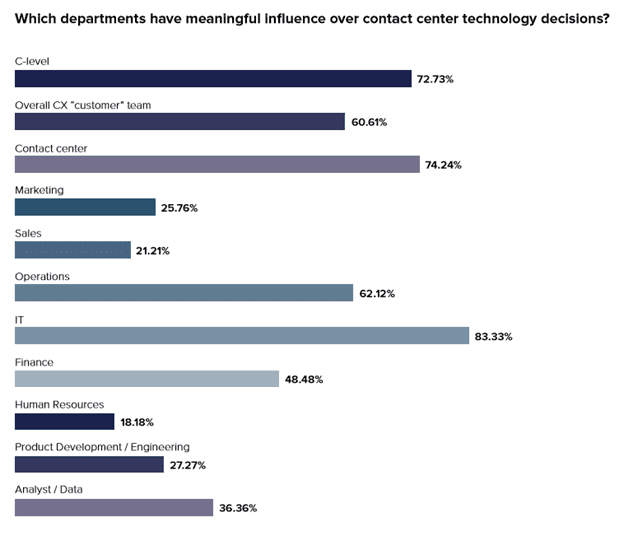We see this every day. The push/pull between technology and human emotional intelligence. The IT department may run the systems, but it’s the CEO who’s responsible to stakeholders — all stakeholders. We must remember technology is a tool that should improve, enhance, reduce something related to people.
“The only constant in life is change.” ~Heraclitus.
Companies resist it. Customers demand it.
This dichotomy represents the yin/yang for most organizations but especially within enterprise call centers.
We see this every day. The push/pull between technology and human emotional intelligence. The IT department may run the systems, but it’s the CEO who’s responsible to stakeholders — all stakeholders. We must remember technology is a tool that should improve, enhance, reduce something related to people.
Reading down the following list of department influencers for contact center technology, you might think, “This is impressive. C-level, 74%, Contact Center, 72%…uh oh, IT, 83%. What’s that about?” 
On the one hand, customer service at the contact center is a company-wide focus. But too many companies minimize the contact center team’s influence.
“Why would 26% of organizations make decisions without consulting the people who are using the technology? writes Brian Cantor, principal analyst and director for CCW Digital in the 2020 CCW Market Study: The State of Contact Center Technology. [PDF]
“Why would they be more inclined to listen to teams with no direct involvement in the work?”
Indeed.
In this era of digital disruption, every business needs to focus on two things: its customers and its employees.
The research presented in the 2020 CCW Market Study bears this out. By every measure, proactively resolving customers’ needs, reducing customer effort, and maintaining consistency across touchpoints are key business objectives today and in the near term.
What Do You Know Now and Where Are You Going?
It’s been said, the road to enlightenment begins with the first step. Companies claim they want to improve the customer experience yet fail at mapping the customer journey with any success.
Previous CCW Digital research confirms that roughly two-thirds of organizations map their customer journeys, yet their March 2020 Market Study reports only 9% believe they are successfully mapping such journeys.
Companies are not just failing to use artificial intelligence and/or automation to learn more about customers’ cross channel activity. If you’re not getting feedback about customer demands and their engagement with your business, then you cannot begin to understand their pain points or intent.
With this crucial information, you can begin to design, map and manage the entire customer lifecycle.
Can Your Call Center Reduce Customer Complexity, Really?
Customer complexity has grown exponentially over the past decade. Historically, calling a company’s contact center represented an invitation to phone hell. Consumers today are more tech-savvy and more likely to contact you across multiple channels. Often, they view calling an agent as a last resort.
This self-service approach to problem-solving makes the engagement process more convenient but may make a call center agent’s job more challenging. Webchat, social media, and e-mail require agent cross-training. These channels also require different skills, such as spelling and grammar, rather than navigating traditional call center scripts.
Training on the right use of tone represents another key component of effective online communication. Social posts adopt a much more casual tone than e-mail, while Webchat may require a breezier voice.
Remember, although the customer journey has changed, the result remains the same – anyone contacting your business regardless of channel wants their problem resolved or their question answered – now.
An effortless quality customer experience demands expertise from both people and technology. That’s where the right technology can affect the most powerful change.
Are You Asking the Tough Questions?
Companies must start by asking tough questions and bringing the right people to the table. You need the business insight of those working on the front lines — Contact Center leaders. Who better understands what’s missing for both the customer and the agent?
Then why do almost 25% of companies surveyed who purchase contact center technology do not involve the contact center team?
The word “empower” can be overused, but technology can empower contact center agents when you employ it diligently. We believe that companies who embrace self-awareness and honest self-appraisal will make the most of their technology investments.
Ask yourself, how do we as a company:
- Reduce customer effort?
- Map the customer journey?
- Exploit call center automation?
- Design a consistent digital experience?
With those answers in hand, making hard decisions, like dumping legacy systems, won’t feel so shocking or painful. After all, “44% of companies say legacy platforms prevent them from improving their technology,” Cantor states.
Can one technology platform truly resolve yawning operational gaps?
We believe so.
Learn how Uniphore can help you live to fight another day. Schedule a demo and we’ll show you how.
*2020 CCW MARKET STUDY | The State of Contact Center Technology, March 2020
)